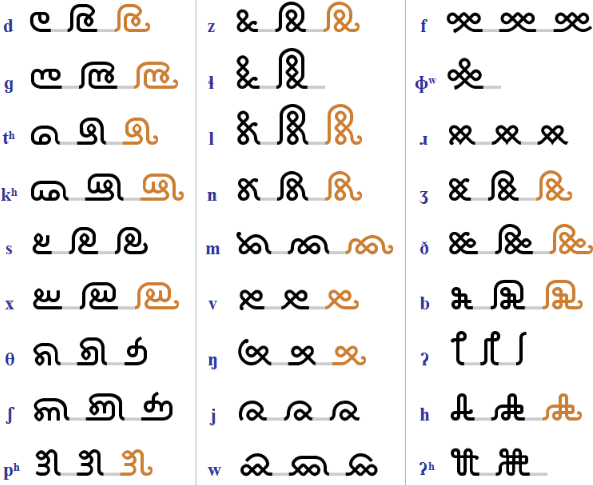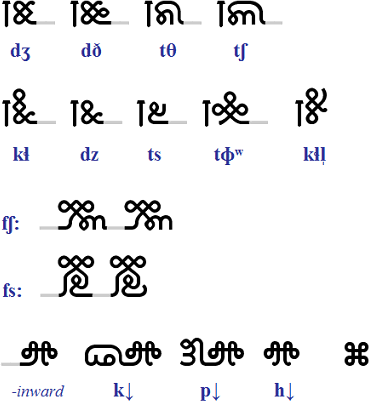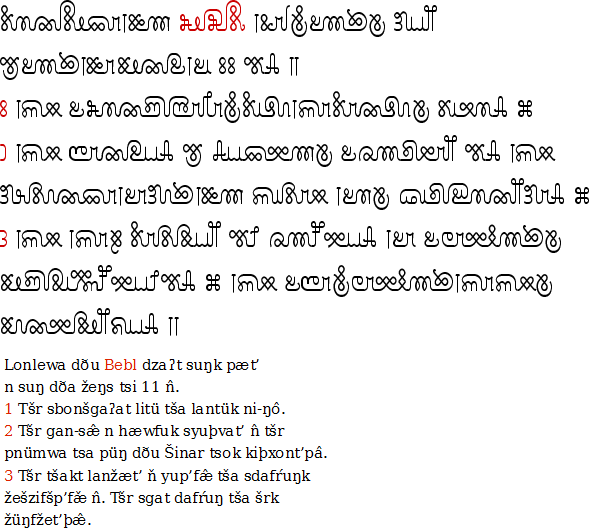This is the 37th version of the SIGIL script, used to write the invented language Sgai. It was created by Ian James in 2013, though the language has been in development since 2006. This script version is formally known as Slinseng-Fi, "syllables drawn as a thread". It is fully cursive, limited only by the grammar (morphology), but usually a whole word or phrase is written with a single stroke.
Here the primary consonants are shown with their initial, medial and final forms. Many connected consonant finals shown here are not used in Sgai, but may be useful for transliterating foreign words; they are shown in orange. The medial and final semivowels /j/ and /w/ may also be used as the second element of diphthongs.

Schwa is always short, and voiced or unvoiced depending on the voice of the previous consonant; it helps to create sesquisyllables. It only comes after plosives and may be omitted in writing. The other vowels tend to be long. Many vowels have a specifically final form in writing. Explicit tonemarks may be suffixed in some situations (pure Sgai does not use low or high tone).

There are three medial-only consonants: the flap, and two special sequences featuring short /ja/ and /wa/ (which are rare in requiring a lift of the pen).
The "nasalizer" follows a vowel and in practice tends to one of the three nasal consonants depending on sandhi with a following consonant. For example, before /b/ the nasalizer will tend to be pronounced /-m/. If the nasalizer is word-final, it sounds as /-ng/.
Long /s/ is a grammatical prefix written with a solo glyph. The double /r/ glyph is a consonant with vocalic extension. Double /n/ is similar, but may also take a tone suffix. The final /t/, /k/ and /kt/ are solo forms. Ejectives are a distinctive feature of Sgai.

A disconnected prefix like a thin T is used before a fricative to signal the arising of an implicit initiating plosive. In most cases that will be /d/ or /t/ for voiced and unvoiced fricatives respectively. There is a solo form for /khl/ + vocalic /l/.
There are two ligatures featuring fricative slurs, which in these cases act as grammatical units. Fricative slurs occur quite often in Sgai, as a final fricative meets an initial fricative of a nearby phonemic location.
For certain unvoiced consonants, an inward airflow can be applied. Inward /h/ is basically an inbreath. Symmetrical loop units may be used to show logical divisions.

As with all the numeral systems of SIGIL scripts so far, this version’s system is based on joining designated numbers of dots. Only FIVE, SEVEN and NINE use more than one stroke. A single glyph is used for a set of three zeroes (thousands).

This is part of a translation of Genesis 11, the Tower of Babel text. The transliteration below it is not pure IPA, but uses a set of familiar European letters.

This page is based on www.skyknowledge.com/sig37.htm
Feedback about Slinseng-Fi may be sent to [ianrjames at hotmail dotcom]
Akkhara Muni, Amethyst, Bostani, Elektrum, Fontok, Klaekson-Zaen, Maui, New Akha, New Maori, New Mong, Pranish, SIGIL, Sigil Panel Script, Slinseng-Fi, Tengwar for Scottish Gaelic, Xylphika
See also: http://www.skyknowledge.com/orthographies.htm
Constructed scripts for: Ainu | Arabic | Chinese languages | Dutch | English | Hawaiian | Hungarian | Japanese | Korean | Lingala | Malay & Indonesian | Persian | Tagalog / Filipino | Russian | Sanskrit | Spanish | Taino | Turkish | Vietnamese | Welsh | Other natural languages | Colour-based scripts | Tactile scripts | Phonetic/universal scripts | Constructed scripts for constructed languages | Adaptations of existing alphabets | Fictional alphabets | Magical alphabets | A-Z index | How to submit a constructed script
[top]
You can support this site by Buying Me A Coffee, and if you like what you see on this page, you can use the buttons below to share it with people you know.

If you like this site and find it useful, you can support it by making a donation via PayPal or Patreon, or by contributing in other ways. Omniglot is how I make my living.
Note: all links on this site to Amazon.com, Amazon.co.uk
and Amazon.fr
are affiliate links. This means I earn a commission if you click on any of them and buy something. So by clicking on these links you can help to support this site.
[top]